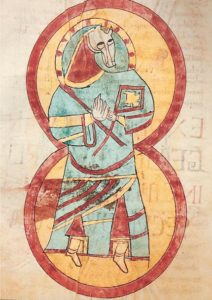Exposition : Le rayonnement de l’école de Saint-Victor
Le rayonnement de l’école de Saint-Victor :
Manuscrits de la Bibliothèque Mazarine
22 septembre – 7 novembre 2008

(c) Bibliothèque Mazarine. Ms 143. Bible glosée (ca 1210)
Depuis l’époque révolutionnaire, la Bibliothèque Mazarine conserve un très riche fonds de manuscrits issus d’établissements religieux parisiens. Nombreux sont les volumes qui proviennent de l’abbaye de Saint-Victor ou qui contiennent des œuvres de chanoines victorins. Cette abondance s’explique avant tout par le destin exceptionnel de l’abbaye de Saint-Victor de Paris. Fondé en 1108 par le maître parisien Guillaume de Champeaux, l’établissement situé en contrebas de la Montagne Sainte-Geneviève devient, en quelques dizaines d’années, une puissante abbaye de chanoines réguliers sous l’abbatiat de Gilduin, mort en 1155. À la même époque, l’école de Saint-Victor s’affirme comme l’une des plus remarquables de l’Occident médiéval. Sa fortune intellectuelle s’explique par une lignée de maîtres se succédant tout au long du XIIe siècle et par la diversité des domaines où ils se sont illustrés.
Hugues, Achard, Godefroid, André, Richard ou encore Garnier ont contribué à renouveler aussi bien les méthodes pédagogiques, les sciences et techniques, la géographie et l’historiographie, que l’exégèse biblique, la systématisation théologique et la spiritualité, la poésie liturgique et la pastorale. Le rayonnement international de Saint-Victor se fait sentir tant chez les auteurs scolastiques du XIIIe siècle que chez les représentants d’une spiritualité plus méditative (/devotio moderna/) aux XIVe et XVe siècles.
La bibliothèque de Saint-Victor est l’une des plus prestigieuses du Moyen Âge. Elle gagne une renommée égale à celle de l’école et devient aux XIVe-XVe siècles un des réceptacles du pré-humanisme français (Nicolas de Clamanges, Jean Gerson).
Cette exposition a été réalisée dans le cadre du colloque : /1108-2008 : L’influence et le rayonnement de l’école de Saint-Victor de Paris au Moyen Âge/, qui a eu lieu du 24 au 27 septembre 2008 au Collège des Bernardins
Catalogue de 10 pages, rédigé par Cédric Giraud (Université de Nancy 2) et Patricia Stirnemann (IRHT-CNRS).
Du lundi au vendredi, de 10 h à 18 h (sauf les 7, 15, 21, 23 et 28 octobre après-midis). Entrée libre.
Bibliothèque Mazarine [Lien]
23, quai de Conti
75006 Paris
Isabelle de Conihout
conservateur en chef, fonds ancien
Unité de Recherche en Histoire médiévale (Bruxelles)
Programme des conférences de l’URHM pour l’année académique 2008-2009 :

Alain DIERKENS Directeur de l’Unité
Benoît BEYER de RYKE Secrétaire de l’Unité
Site : www.ulb.ac.be/philo/urhm
British Library : Catalogue of Illuminated Manuscripts
A consulter, l’intéressant glossaire rattaché au catalogue en ligne des manuscrits enluminés de la British Library :
[Lien]
Encore un manuscrit du « Roman de la Rose » enluminé par le « Maître de Thomas de Maubeuge » …
Lot 62 de la vente Aguttes du 3 juillet 2008 (Neuilly)
Manuscrit enluminé sur vélin, premier quart du XIVe siècle, de 11 miniatures attribuées au Maître de Thomas de Maubeuge. 136 f. non numérotés, complet avec 17 cahiers de 8 f. 175 x 250 (125 x 185) mm, réclames en fin de cahiers, copié à l’encre brune par une seule main. 2 colonnes de 40 lignes. Réglé à la pointe sèche. Nombreuses lettrines filigranées peintes en rouge ou bleu, avec filigranes de ton opposé bleu-vert ou rouge, rubriques en rouge [la première rubrique au f. 5 : Ci parole oiseuse], une initiale de 8 lignes de hauteur (f. 27) ouvrant le texte de Jean de Meung, d’or sur fond bleu avec un champ rose foncé agrémenté de motifs dorés. Couvrure d’attente en vue de recevoir une reliure jamais réalisée (avec cahiers reliés et couverts de parchemins notariés du XVIIIe siècle portant des timbres de la Généralité d’Orléans).
Texte f. 1-27, Guillaume de Lorris. Incipit: Maintes genz dient que en songes // N’a se fables non et mençonges… Explicit: […] Que je n’ai mes aillors fiance (v. 1-4028) ; f. 27-136, Jean de Meung, rubrique, Ci comence mestre Jehan de Meun; incipit : Et si l’ai ge perdue espoir…Explicit: […] A tant fu jor et je m’esveille. Explicit li roman de la rose (v. 4029-21750)
Décoration Manuscrit illustré de 11 miniatures : f. 1 : L’Amant endormi, surmonté d’un décor de rose, est visité par Danger qui porte un bâton. Cette image débute tous les Romans de la rose du XIVe siècle, dont ceux du Maître de Thomas de Maubeuge. Miniature en frontispice ; initiale ornée avec prolongement de baguettes ; scène de poursuite d’un lièvre par une hermine ; f. 1v : Haine et l’Amant ; f. 2 : (1) Amant avec Vilainie et Felonie qui lui donne une coupe ; (2) Convoitise et l’Amant ; (3) Avarice et l’Amant ; f. 2v : Envie et l’Amant ; f. 3, (1) Tristesse et l’Amant ; (2) Vieillesse et l’Amant ; f. 3v : L’Amant avec Papelardie ; f. 4 : L’Amant et Pauvreté vêtu de blanc tenant un bâton ; f. 27: L’auteur Jean de Meung à son pupitre visité par l’Amant.
Le Maître de Thomas de Maubeuge se reconnaît aux grands yeux angulaires, les lèvres et les joues rehaussées de rouge, les cheveux élégamment bouclés sur le front. Ce Maître a peint cinq Romans de la Rose : Frankfurt Stadt-und-Universitatsbibliothekek lat Qu 65 ; Paris, Bibl. de l’Arsenal ms. 3338, Paris, BnF. fr 1559 ; 9345 ; 12589. Cet artiste est connu sous le nom de Maître de Thomas de Maubeuge d’après le libraire parisien Thomas de Maubeuge mentionné pour la première fois en 1343. Il travaille en 1313 pour la comtesse Mahaut d’Artois qui lui commande une Bible en français et une Vie de saint. Il est mentionné jusqu’en 1349. Ce libraire emploie régulièrement pour les commandes de prestiges deux enlumineurs, à savoir le Maître de Fauvel et le Maître de Thomas de Maubeuge. Il a peint plusieurs manuscrits dont un code de Justinien pour le roi Charles V en 1342 (S. Cassagnes Brouquet, L’image du monde un trésor enluminé de la Bibliothèque de Rennes, Rennes, 2003).
De même, voir Rouse & Rouse, Manuscripts and their makers, tome II, appendix 7F: Manuscripts illuminated by the Master of Thomas de Maubeuge, p. 176-179.
Provenance : 1. Marque de possesseur (fin XVe ou début XVIe s.) inscrite à l’encre au recto du f. 136 et formulée à deux reprises. Encre très pâle, presque invisible : Ce livre est a Pierre Chevrier, seigneur de Ville[neuve]; C’est a P. Chevrier, seigneur de Javanrennes. La famille Chevrier est une famille de la région d’Issoudun, seigneurs de Villeneuve, Breuil-de-Beauvilliers et de Javanrennes. Il semble que Pierre Chevrier ait épousé Catherine Le Roy, fille de André Le Roy, Seigneur de Villeneuve-sur-Cher. Le fils de Pierre Chevrier était André Chevrier, seigneur de Villeneuve, de Janvarennes et Billeron, qui se maria en 1503 (voir G. Thaumas de la Thaumassière, Histoire de Berry, Bourges, 1868, vol. III, p. 84-85 : Seigneurie de Villeneuve). – 2. Propriété en 1887 du Maire de Villeneuve [Villeneuve-sur-Cher ?]. Lettre adressée à M. le Maire de Villeneuve, datée St-Florent [-sur-Cher ?] le 19 octobre 1887 et signée V. Mourié. Ce dernier décrit son exemplaire lacunaire du Roman de la Rose et demande à M. le Maire de Villeneuve (dont le patronyme n’est pas précisé) l’autorisation de photographier le présent exemplaire en sa possession, bien complet du texte.
Source
Catalogue de la vente Aguttes, avec 2 photos. En ligne sur le site Bibliorare [Lien]
Voir d’autres pages [Lien]
PAGES ANNEXES
Auteur du blog : Jean-Luc DEUFFIC




